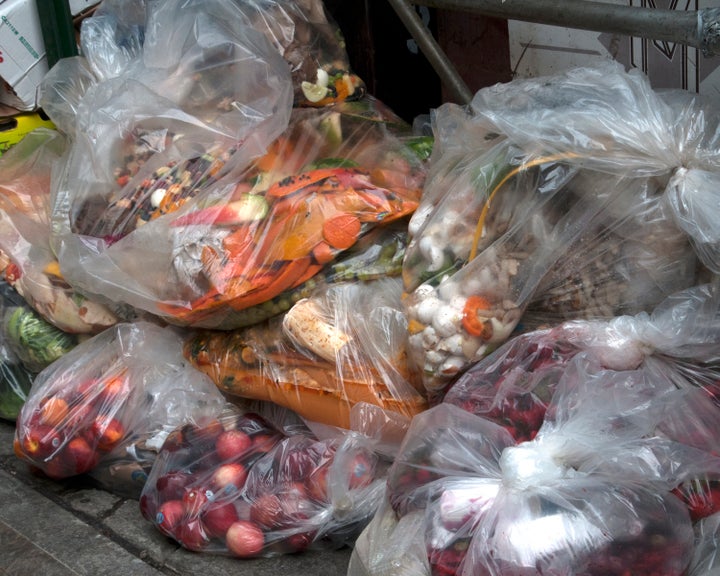
I’m standing in front of fresh artisanal breads, crisp green vegetables, fine gourmet cheeses and pristine slabs of meat. These things are expensive and out of my budget. Or they would be ― except they’re all free.
This seemingly endless buffet is one of the many times I’ve discovered high-quality food while dumpster diving around the U.S. I’ve spent the last four years salvaging discarded food from commercial trash containers.
For those unfamiliar with dumpster diving, I can imagine your reaction might be one of disgust. That’s how I felt when I first heard of it. It’s only natural given that we associate dumpsters with rotten, moldy food and other waste. But the reality is that dumpsters are also places where ridiculous amounts of perfectly edible food get sent once they’re past their sell-by dates (despite still being edible) or even when they just no longer look as “perfect” as they once did. Ever-so-slightly bruised bananas are a great example.
My introduction to the dumpster diving community began back when I was a college student in London. My schedule meant that most of my grocery shopping was done at night as stores were closing up for the evening. It was then that I first witnessed huge volumes of delicious fresh produce ending up in the trash. And when I tried speaking to grocery store employees to find out if I could buy that food cheap, I was always met with shaking heads and excuses about “company policy” and “liability risk.”
In the following years, I traveled the world using dumpster diving as a reliable source of food. The more I did it, the more I came to realize that all this food waste is not limited to a single area or community. This is a global crisis.

Today I’m back home in the U.S., where 40 percent of all food that is produced each year goes to waste (and, if you were wondering, it’s legal in most places to dumpster dive as long as you’re not trespassing). This is the same country where an estimated 40 million people are food-insecure, including more than 12 million children.
Then there’s the environmental impact. It requires a lot of land to produce enough food to feed the 7.7 billion people on this earth. Approximately 11 percent of the world’s land surface is used just for crop production.
Producing food requires huge amounts of water, as well as pesticides and fertilizers that pollute our water sources, and energy to transport the food to consumers. And when uneaten food is left to rot, it produces methane emissions, a potent greenhouse gas that contributes to climate change.
The modern agricultural system has left most people disconnected from the realities of food. Where once we had to hunt, gather, grow, raise and harvest, many of us now only have to consume (via the occasional trip to the grocery store or restaurant). We pay other people to produce and dispose of our food for us, and companies wanting to sell their goods show us idealized visions of what food should look and taste like. Vegetables and fruits that grow in odd shapes are tossed out, and only particular parts of animals are considered edible in many Western cultures ― such as the breast, thighs and wings of a chicken ― with the rest going to waste.
We take what we eat for granted and have forgotten what a privilege it is to have a surplus of easily accessible food.

In seeking my own way to address this problem, I have created Cooking With Trash, a YouTube show that allows me to expose the food waste crisis on a larger platform and to promote dumpster diving as a partial solution.
With some help, grocery stores are also starting to take action. Here in the U.S., organizations such as Feeding America and Food Not Bombs collect “unsellable” food from grocery stores and other businesses, and redistribute it among food-insecure communities. The Good Samaritan Food Donation Act of 1996 generally frees businesses from liability when they donate food to nonprofits. Companies can also claim tax deductions on donated foods. Together, these programs and laws offer convenient incentives for every business to repurpose unwanted food.
That said, there really is no excuse for why so much food waste exists in the first place. Although I’m a dumpster diver, I hope to see a time when I struggle to find free, tasty, edible food being trashed and when dumpsters are reserved solely for actual waste. In the mean time, dumpster diving is one way for us all to get proactive in reducing food waste. It might not be a permanent solution but it’s a start.
For more content and to be part of the “This New World” community, follow our Facebook page.
HuffPost’s “This New World” series is funded by Partners for a New Economy and the Kendeda Fund. All content is editorially independent, with no influence or input from the foundations. If you have an idea or tip for the editorial series, send an email to thisnewworld@huffpost.com
